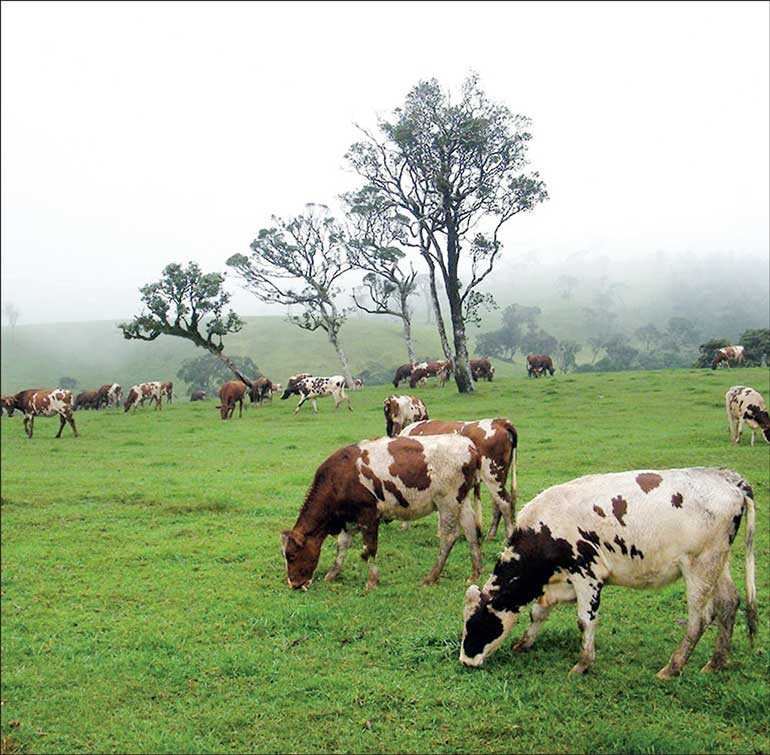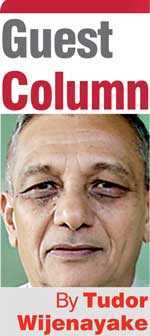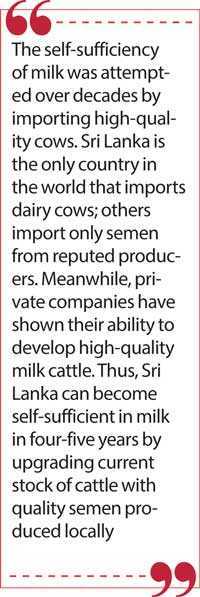Thursday Apr 24, 2025
Thursday Apr 24, 2025
Wednesday, 17 March 2021 00:00 - - {{hitsCtrl.values.hits}}

Pure high-bred cattle are suited for high altitudes and other areas could be supplied with cross-breeds
 Reaching self-sufficiency in milk had been the country’s dream. In 2014 Minister Basil Rajapaksa wished to import 20,000 heifers (cows that have not borne a calf) from Australia, aimed to achieve self-sufficiency in milk by 2020. Yahapalanaya Government brought down 2,000 heifers from New Zealand in May 2017, also 3,000 heifers in December 2017 from Australia.
Reaching self-sufficiency in milk had been the country’s dream. In 2014 Minister Basil Rajapaksa wished to import 20,000 heifers (cows that have not borne a calf) from Australia, aimed to achieve self-sufficiency in milk by 2020. Yahapalanaya Government brought down 2,000 heifers from New Zealand in May 2017, also 3,000 heifers in December 2017 from Australia.
During the budget speech in November 2021 PM and FM Mahinda Rajapaksa stated that the Government policy is to reduce import of milk powder, costing $ 300 million per annum (Rs. 55 billion), by increasing domestic dairy production.
In February 2021, Minister of Agriculture Mahindananda Aluthgamage informed the Parliament that the Government is aiming self-sufficiency in liquid milk within the next four years; also, state lands would be released for the purpose.
Lifespan of a cow
A cow left alone in the open will live for around 20 years. In dairy farms of developed countries heifers around 13 months are artificially inseminated to produce a young one after a gestation period of nine months. New-born calves are separated from their mothers usually within three days and the mothers are inseminated again within three months; they are expected to produce milk for 10 months.
In the under-developed dairy industry, cows are considered as milk-yielding machines producing over 20 litres of milk a day. A high-producing dairy cow has an average productive lifespan of approximately three to four years, yielding three or four calves during the period.
In Sri Lanka we have no indigenous cattle left; all have been crossed with imported varieties to some extent, mostly Indian, over a long period.
Milk production
According to Department of Animal Production and Health (DAPH) available at www.daph.gov.lk, the average milk production in each province in litres/per cow/day, is given below:
Central 6
Eastern 1
North Central 1
North Western 2
Sabaragamuwa 2
Southern 1
Uva 2
Western 3
Also, district-wise Kandy – 5, Matale – 3, Nuwara Eliya – 10, Colombo – 3, Gampaha – 3 and Kalutara – 2, show marked different production values. Most relevant is the poor milk output in dry regions of the country. Thus, attempts to improve milk production in these areas need careful attention.
DAPH produces high-quality cow semen at their artificial insemination stations, Kundasale and Polonnaruwa, which are distributed to the public through their veterinary officers and have been responsible for improving quality of cattle throughout the country.
Large farms in Sri Lanka
NLDB farms
The Land Reform Act of 1957 brought large tracts of private lands under government control. National Livestock Development Board (NLDB) was established in 1973 and large extents were handed over to the Board to establish farms for upgrading indigenous herds to high-producing dairy cattle. In addition, in 1992, 13 farms under the Department of Animal Production and Health were handed over to the Board. Resulting, over 14,000 ha of lands under the board including 4,800 ha of coconut in the coconut triangle.
NLDB manages the largest stock of cattle in the country with 31 livestock and crop integrated farms. The Board also has a training centre to impart practical and theoretical knowledge to farmers. The major farms include Rideegama, Bopaththalawa, Nikaweratiya, Polotthalawa, etc.
 Rideegama Farm
Rideegama Farm
Rideegama Farm is located near Hambantota with 662 ha of pastures, among the driest regions in the country. In 2015 when imported milk cows were unloaded at Hambantota harbour, the farm was given the responsibility in handling 2,500 imported cattle of breeds of Jersey x Frisian and pure Jersey. The farm was expected to carry out a planned cropping program under the pivot irrigation system also with rain water. But the achievements reached are not available in public domain.
Bopathalawa Farm
The farm in Nuwara Eliya district was managed by the Department of Agriculture and later by the Department of Animal Production and Health. In 1992, the farm was handed over to NLDB. The farm received 500 Australian cows in March 2012, also in 2013 the farm was allocated with 247 Friesian and Jersey-Friesian crosses imported from Australia.
The farm provides in-plant training to the undergraduates/diploma holders of veterinary surgeon stream.
Nikaweratiya Farm
Nikaweratiya Farm consisting 734 ha is located in the intermediate area between wet and dry zones. The farm commenced operations in 1983 to produce drought cattle, with Indian varieties such as Khillari, Kangayans and Hariyanas. Pure bred Sahiwal cattle and Nilli Ravi buffaloes were introduced in 1991; in 1992 the farm was handed over to NLDB.
In addition, 245 ha Polonthalawa farm, a coconut estate also in Nikaweratiya, was taken over under the Land Reforms Act, and handed over to NLDB in 1974.
Other farms
Ambewela Dairy Farm
The farm owned by Lanka Milk Foods spreads across 1,500 acres at an elevation of 6,000 feet. In 1966, the farm received 700 Jersey heifers brought from New Zealand and was renamed New Zealand Farm. The farm maintains purebred 2,000 Friesian and Ayrshire heads of cattle, maintained with artificial insemination with imported semen from USA and Finland, while minimising birth of male calves.
The animals at Ambewela Farm are fed with rye-grass containing a high percentage of protein, grown with seeds imported from Australia and New Zealand. The cows in the farm produce an average of 22-24 litres of milk per cow per day, the highest average yield in the country.
The farm uses modern machinery for mechanised cultivation. The feed formula is specially designed and produced in the farm’s sophisticated feed mill. The healthcare of the animals is looked after by the resident qualified and well-experienced staff.
Watawala Dairy Ltd.
Watawala Plantations, a large tea plantation company commenced the dairy project on a 50 ha land at Watawala, Ginigathhena in 2016 with 120 cattle. Watawala Dairy received 928 imported cows in 2017, also in 2018 imported 246 heifers from Australia and New Zealand.
Today, the farm manages a herd of 1,600 dairy cattle (1,000 adult cows and 600 heifers) and produces around 18,000 litres of fresh milk per day and releases 6.5 million litres of milk to the local market, or 3.5% of local milk production.
Given the limited space the herd is housed indoors under Loose Barn System. Cows are not caged, collared or tied up and they can maintain their natural behaviour with eating, drinking and laying inside a confined area.
The cattle are fed under Total Mixed Ration (TMR) method, as opposed to grazing. Under the TMR method, maize acts as the main fodder, purchased from maize suppliers from the dry zone.
The dairy farm is fully computerised, with a state-of-the-art milking parlour system monitoring each animal’s yield and quality, the most advanced milking parlours in Sri Lanka.
Pelwatta Dairy
In 2006 Pelwatte Dairy Industries set up a milk processing factory in Monaragala district, capable of handling 100,000 litres of fresh milk per day, purchasing milk from a base of 12,500 small producers with 40 collecting centres throughout the country. The company also has a feed mill with a capacity of 60 MT per day.
The company has a factory to produce milk powder, boasts of delivering quality liquid milk, milk powder, yoghurt, butter, cheese and ice cream.
Lili Cheese
Lili Dairy started in 2006 as a farm house mozzarella cheese producer in a small dairy farm in Giriulla. The company won the Most Innovative Start-up Enterprise award in 2007 and the Best Business Proposal Award in the year 2008.
The company produces Italian cheese mozzarella, ricotta soft cheese, etc. for the Italian restaurants. The company’s natural cheese is being served in most Italian restaurants.
Lili Cheese Factory is located in Delatura, Ja-Ela purchasing milk from around 200 dairy farmers who supply milk for cheese production, but the company claims the supply is insufficient.
Balaji Dairy Farm
Spread over 65 acres in Batticaloa District, Balaji Farm was founded in 2012 and boasts of being the country’s largest breeding farm, housing up to 250 cows and 400 heifers and having mechanised the entire milking process maximising quality and hygiene.
Balaji Farm, offers well-bred pregnant Holstein, Friesian, Jersey crossed heifers for sale. These heifers are conceived with natural breed of semen, making the next generation bigger, stronger and faster to reach milk production.
The Company also offers sexed semen, ensuring 95% of the new arrivals are females, while improved genetics help farmers to achieve an improved second generation.
Increasing milk production
The local production of milk is only 50% of demand forcing the balance to be imported. The issues hampering the production are shortage of cattle numbers, poor milk output from cows, shortage of feeding grass and poor usage of available resources. A high yielding cow requires one-tenth of its weight of fodder a day, a large quantity of water and would give out a lot of urine and dung, a problem or an asset as one looks at.
Reaching the self-sufficiency would require increasing the cattle numbers, also improve the milk output of cattle. The cattle from Eastern, North Central and Southern Provinces average only one litre per day as shown before. Thus, improving the output towards 5 litres/day would be essential to attain self-sufficiency.
Cattle in Eastern Province
The cattle in the east, also in dry regions face shortage of grass, as most lands are paddy cultivated or are jungles. The owners allow their cattle to roam around for grass and they barely manage to feed for survival. Only milking cows are kept near the gardens, but again grass is in short supply, resulting in poor milk output. None of them are given food supplements. The shortage of grass forces some cattle owners to send cattle into jungles creating a conflict with elephants. But most cattle in jungles are not milked but are sold for slaughter.
Abandoned paddy lands
Meanwhile, in Colombo and Gampaha districts large acreages of paddy lands with plenty of water are uncultivated, as their owners are engaged elsewhere and farm workers cannot be found. Under the existing laws paddy lands left uncultivated over a period could be taken over by the Government. Thus, if the abandoned paddy lands are utilised for fodder cultivation, milk shortage could be averted.
Pasteurised milk
Currently consumers use powdered milk or liquid milk in plastic/paper packs selling a litre around Rs. 260, but the milk producers get around Rs. 75 a litre. A better way would be to deliver pasteurised milk in reusable glass bottles at around Rs. 175 a litre. The milk could be delivered to households in Colombo and Gampaha districts by the same bread (chuun-paan) delivery persons.
Colombo and Gampaha districts could be divided among the major milk producers who would purchase milk from small/medium producers. Land owners with minimum half acre unused lands adjoining a paddy field (allowing cattle urine, etc. to be disposed) could be invited to open up cattle farms and be trained to look after cattle, helped financially to establish cattle sheds and the purchase of cattle. Their fodder requirement would be supplied by cultivators on abandoned paddy fields, with the Government having taken over the paddy lands. The cattle farmers, also the fodder cultivators would be trained in agricultural department or in NLDB farms.
Workers for milk farms
In the country’s dry regions cattle gives poor milk yields, but farmers continue to rear cattle with no other employment. The cattle need be upgraded and moved to areas with better fodder, thus the owners need be encouraged to sell their young female cattle to the Government, to be raised in agricultural department or NLDB farms. Children of cattle farmers lack employment opportunities; they can be trained to look after cattle by the Government. During the training they can be paid an allowance similar to industrial trainees and offered employment with milk producers in Colombo/Gampaha districts, a win-win situation. Some of them could become fodder farmers with mechanised harvesting.
Poor contribution from NLDB
NLDB owning 31 farms controls 14,000 ha of lands including 4,800 ha of coconut lands. But the only NLDB products available in supermarkets are packeted milk and yoghurt. Most other brands offer butter and varieties of cheese.
NLDB’s annual report for 2011 (last report on public domain) presented in 2017, informs their cattle numbers as 8,068, and buffaloes 2,534. The report informs the reduction of milk output in their farms from 3.2 litres in 2010 to 2.8 in 2011 litres.
The organisation controlling 14,000 ha of land, has only a total of 10,602 animals, less than one animal per ha. Can the country afford the largest land-holder to neglect the sector? Compare the output with other private farms given before. The failure to upgrade records in public domain and poor contents indicate deficiencies in administration. Thus, some farms run by NLDB would be better managed by efficient companies. Also pushing the organisation for higher efficiencies would be essential to achieve self-sufficiency in milk.
Importing cattle
The country imported over 9,500 pregnant cows between 2012 and 2017, but large numbers have died. Press photographs showed cattle in ships standing in a couple of inches of water and cow urine, would have led to multiple problems. The cow recipients were not trained to handle imported cattle nor the need of quality and quantity of fodder and water; thus, milk output falls way behind. Only large private farms were able to handle imported cattle properly.
Discussion
The self-sufficiency of milk was attempted over decades by importing high-quality cows. Sri Lanka is the only country in the world that imports dairy cows; others import only semen from reputed producers. Meanwhile, private companies have shown their ability to develop high-quality milk cattle. Thus, Sri Lanka can become self-sufficient in milk in four-five years by upgrading current stock of cattle with quality semen produced locally.
Pure high-bred cattle are suited for high altitudes and other areas could be supplied with cross-breeds. For higher milk production cattle need to be kept in sheds and be given large quantities of grass and water, a neglected aspect. In addition, cattle stocks need continuous upgrading with artificial insemination.
Uncultivated paddy lands in Colombo and Gampaha could be utilised for producing high quality fodder for improved cattle rearing, leading to home-delivered pasteurised milk to consumers at lower prices.
High-quality grass suited for each area needs to be selected for cultivation and harvesting with machinery. Thus, agricultural department farms located throughout the country have the responsibility of offering fodder types and training cultivators. Horana and Gampaha farms have the responsibility of selecting suitable fodder varieties for cultivation in abandoned paddy fields.
NLDB controlling 14,000 ha of land, has only a total of 10,602 animals, less than one animal per ha. Meanwhile Balaji Farm in Batticaloa occupying only 65 ha rear 250 cows and 400 heifers offers high quality pregnant heifers for sale, also sexed semen, ensuring 95% females. If the company is allocated with a farm from Kurunegala district (say) from NLDB, the Company could improve their service. In addition, Watawala Farm which currently rears 1,600 cattle on 50-acre land could be allocated with a high elevation farm from NLDB. Handing over farms to the private sector would shock the Board officials and farm managers from their lethargy and move towards proper utilisation of resources under their care.
With proper feeding, an output of 20 litres from high elevation cows and 10 litres from low country cows would not be difficult. Thus, self-sufficiency in milk is not far away and could be achieved in four to five years, but the article’s contents need to be brought to the notice of the President, requiring action.
Discover Kapruka, the leading online shopping platform in Sri Lanka, where you can conveniently send Gifts and Flowers to your loved ones for any event including Valentine ’s Day. Explore a wide range of popular Shopping Categories on Kapruka, including Toys, Groceries, Electronics, Birthday Cakes, Fruits, Chocolates, Flower Bouquets, Clothing, Watches, Lingerie, Gift Sets and Jewellery. Also if you’re interested in selling with Kapruka, Partner Central by Kapruka is the best solution to start with. Moreover, through Kapruka Global Shop, you can also enjoy the convenience of purchasing products from renowned platforms like Amazon and eBay and have them delivered to Sri Lanka.
Discover Kapruka, the leading online shopping platform in Sri Lanka, where you can conveniently send Gifts and Flowers to your loved ones for any event including Valentine ’s Day. Explore a wide range of popular Shopping Categories on Kapruka, including Toys, Groceries, Electronics, Birthday Cakes, Fruits, Chocolates, Flower Bouquets, Clothing, Watches, Lingerie, Gift Sets and Jewellery. Also if you’re interested in selling with Kapruka, Partner Central by Kapruka is the best solution to start with. Moreover, through Kapruka Global Shop, you can also enjoy the convenience of purchasing products from renowned platforms like Amazon and eBay and have them delivered to Sri Lanka.